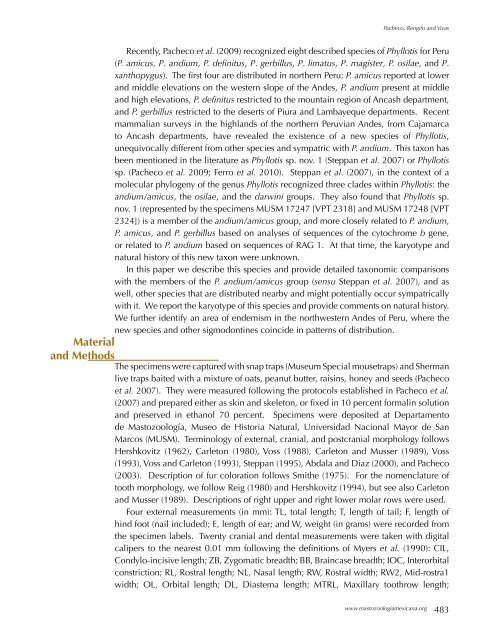therya-5_2
therya-5_2
therya-5_2
You also want an ePaper? Increase the reach of your titles
YUMPU automatically turns print PDFs into web optimized ePapers that Google loves.
Pacheco, Rengifo and Vivas<br />
Material<br />
and Methods<br />
Recently, Pacheco et al. (2009) recognized eight described species of Phyllotis for Peru<br />
(P. amicus, P. andium, P. definitus, P. gerbillus, P. limatus, P. magister, P. osilae, and P.<br />
xanthopygus). The first four are distributed in northern Peru: P. amicus reported at lower<br />
and middle elevations on the western slope of the Andes, P. andium present at middle<br />
and high elevations, P. definitus restricted to the mountain region of Ancash department,<br />
and P. gerbillus restricted to the deserts of Piura and Lambayeque departments. Recent<br />
mammalian surveys in the highlands of the northern Peruvian Andes, from Cajamarca<br />
to Ancash departments, have revealed the existence of a new species of Phyllotis,<br />
unequivocally different from other species and sympatric with P. andium. This taxon has<br />
been mentioned in the literature as Phyllotis sp. nov. 1 (Steppan et al. 2007) or Phyllotis<br />
sp. (Pacheco et al. 2009; Ferro et al. 2010). Steppan et al. (2007), in the context of a<br />
molecular phylogeny of the genus Phyllotis recognized three clades within Phyllotis: the<br />
andium/amicus, the osilae, and the darwini groups. They also found that Phyllotis sp.<br />
nov. 1 (represented by the specimens MUSM 17247 [VPT 2318] and MUSM 17248 [VPT<br />
2324]) is a member of the andium/amicus group, and more closely related to P. andium,<br />
P. amicus, and P. gerbillus based on analyses of sequences of the cytochrome b gene,<br />
or related to P. andium based on sequences of RAG 1. At that time, the karyotype and<br />
natural history of this new taxon were unknown.<br />
In this paper we describe this species and provide detailed taxonomic comparisons<br />
with the members of the P. andium/amicus group (sensu Steppan et al. 2007), and as<br />
well, other species that are distributed nearby and might potentially occur sympatrically<br />
with it. We report the karyotype of this species and provide comments on natural history.<br />
We further identify an area of endemism in the northwestern Andes of Peru, where the<br />
new species and other sigmodontines coincide in patterns of distribution.<br />
The specimens were captured with snap traps (Museum Special mousetraps) and Sherman<br />
live traps baited with a mixture of oats, peanut butter, raisins, honey and seeds (Pacheco<br />
et al. 2007). They were measured following the protocols established in Pacheco et al.<br />
(2007) and prepared either as skin and skeleton, or fixed in 10 percent formalin solution<br />
and preserved in ethanol 70 percent. Specimens were deposited at Departamento<br />
de Mastozoología, Museo de Historia Natural, Universidad Nacional Mayor de San<br />
Marcos (MUSM). Terminology of external, cranial, and postcranial morphology follows<br />
Hershkovitz (1962), Carleton (1980), Voss (1988), Carleton and Musser (1989), Voss<br />
(1993), Voss and Carleton (1993), Steppan (1995), Abdala and Diaz (2000), and Pacheco<br />
(2003). Description of fur coloration follows Smithe (1975). For the nomenclature of<br />
tooth morphology, we follow Reig (1980) and Hershkovitz (1994), but see also Carleton<br />
and Musser (1989). Descriptions of right upper and right lower molar rows were used.<br />
Four external measurements (in mm): TL, total length; T, length of tail; F, length of<br />
hind foot (nail included); E, length of ear; and W, weight (in grams) were recorded from<br />
the specimen labels. Twenty cranial and dental measurements were taken with digital<br />
calipers to the nearest 0.01 mm following the definitions of Myers et al. (1990): CIL,<br />
Condylo-incisive length; ZB, Zygomatic breadth; BB, Braincase breadth; IOC, Interorbital<br />
constriction; RL, Rostral length; NL, Nasal length; RW, Rostral width; RW2, Mid-rostra1<br />
width; OL, Orbital length; DL, Diastema length; MTRL, Maxillary toothrow length;<br />
www.mastozoologiamexicana.org<br />
483



